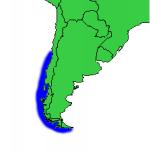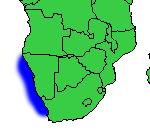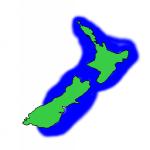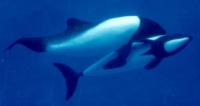 |
|
Genus CephalorhynchusEach of the four species in the genus Cephalorhynchus is found in the Southern Hemisphere. Some of the world's least known dolphins, like the black and Heaviside's dolphins, belong to this genus. Each species has its own range with virtually no overlap, except a small area in the Strait of Magellan where both the black and Commerson's dolphins may be found. All specimens are strongly marked, with shades of black and white or black, white, and gray. One author suggested the term "skunk dolphins" for individuals of this genus. Other than that, there are no accepted common names for this genus. Sometimes the names "short-nosed dolphins" and "southern dolphins" are used. All species of this genus are small, with a maximum length of only 1.83 meters, most being smaller. Most also have around 25-32 pairs of teeth in each jaw. Individuals are generally shy, which contributes to their obscurity. The name Cephalorhynchus roughly translates to "head-beak," with kephalos meaning "head" and rhynchus meaning "beak" or "snout." | ||||
 Distribution Map
Distribution Map(Click for larger version) |
The Commerson's dolphin is in many ways a typical member of the genus Celphalorhynchus, with a small size, brilliant coloration, and rounded dorsal fin. It has a comparatively limited and isolated distribution, found only along the eastern coast of the southern tip of South America, from Peninsula Valdés, Argentina, to Tierra del Fuego, Chilean waters south of 51° S., the Falkland Islands, and the Kerguelen Islands in the southern Indian Ocean. The middle portion of each of the sides of its small, stocky body is white, while the head, flippers, flukes, posterior, dorsal fin, and dorsal surface are black. There is a white patch on the ventral surface of the anterior region, and a black patch on the otherwise white ventral surface just caudal to the midline. The demarcation between the black and white portions of the body are sharp. The small size, stocky build, and lack of a descernable beak bear a resemblance to the porpoise, but the vivacious behaviour patterns and the cone-shaped teeth are distinctly dolphin-like. The names "skunk dolphin," "Black-and-White Dolphin," "Puffing Pig," and "Jacobite" have been used to refer to this species. Although it is sometimes stated that Commerson's dolphin is shy of boats, modern accounts describe individuals frequently bow riding and pacing vessels from alongside. They breach often and swim erratically, many times upside down or on their side. Dives normally last 15-20 seconds after breathing between 2 and 3 times. Individuals have been seen associating with Peale's and Black dolphins and Burmeister's Porpoises. | ||||
 Distribution Map
Distribution Map(Click for larger version) |
The black dolphin is the least known of the genus Cephalorhynchus, with almost nothing known about the biology or natural history, no records of specimens held in captivity, and almost no formal studies of the species. It appears to be mostly typical of the genus, consuming similar prey, making similar vocalizations, and having the same inherent wariness, which helps to result in its obscurity. The black dolphin is found only in Chilean waters between Valparaiso (about 30° S.) and s. Isla Navarine, just north of Cape Horn, (55°. S.). The most easterly sighting was in the Strat of Magellan, just east of First Narrows (52° 30' S., 60°. 20' W.). It is possible that its range extends south to Cape Horn (around 56° S.). There is very little overlap between the range of the black dolphin and that of the Commerson's dolphin, but they have been seen together in the Strait of Magellan, the Beagle Channel, and Cape Horn. The records are from the edges of their respective ranges. The distribution is more or less continuous within its range; there are no significant gaps that isolate different groups. The black dolphin in many ways resembles the Heaviside's dolphin, with a small adult size of around 1.4 meters, a low, rounded dorsal fin, and dark coloration. It has a white throat and belly, a white spot behind the flipper, and a dark line on the sides running from the cranial to the caudal end. When in the water, it is described as tan, brown, lead-colored, or gray. Out of the water, it is found to be nearly black on most parts and pure white on other parts. After death, the color darkens quickly, especially if the specimen is left in the sun. Its resemblance to various species of the family Phocoena probably represents parallel development as the species occupy similar ecological niches. Cetacean litterature includes many inaccurate descriptions of this species. Very little is known about the black dolphin's behaviour. It is generally not blatant or aggressive, and does not breach often. Individuals are often seen with groups of feeding sea birds. The northern stock is far more gregarious than the southern stock. While in the southern part of the range, individuals are wary of boats and very difficult to approach, those in the northern areas do occasionally approach boats and bow ride. In addition, groups in the north are much larger, sometimes reaching as many as 4,000 individuals. | ||||
 Distribution Map
Distribution Map(Click for larger version) |
Heaviside's dolphin, found in the waters of the Atlantic coast of southern Africa, is not very well known. Its range is restricted, and it is not abundant anywhere within it. It appears to be relatively continuously distributed along approximately 1000 nautical miles on the western coast of southern Africa, from Cape Point (34° 20' S.) in South Africa to at least Bosluisbaai (17° 23' S.) in Namibia, and possibly as far north as southern Angola. The short, robust body of Heavside's dolphin is typical of this genus, although the head is slightly less conical than is normal. There is a groove between the rostrum and the melon. Unlike many other members of the genus, which have distinctly rounded dorsal fins, the dorsal fin of this species is triangular. The color is blue-black on the dorsal side, with a gray "cape" over the head and thorax. There are four areas on the ventral surface without pigmentation. There is a transverse band in front of the pectoral fins, and a trangular spot behind each of the pectoral fins. A longitudinal line is found on the belly. It separtes into three equal forks just beneath the dorsal fin. In many ways the coloration resembles that of the killer whale. Since Heaviside's dolphin does not resemble the killer whale in size or habits, it can only be assumed that this similarity in coloration is a way of confusing their predators as to the identity of the species. At least one albino individual has been reported. Although Heaviside's dolphin is difficult to spot at sea due to its dark dorsal side, it seems to be attracted to moving vessels. It has not been seen feeding on the surface, but seems to like to feed in shallow inshore waters. Either feeding normally takes place at night, or individuals with full stomachs do not like to approach ships, since specimens captured in the afternoon did not have much in their stomachs. | ||||
 Distribution Map
Distribution Map(Click for larger version) |
Hector's dolphin is only found in the coastal waters of New Zealand, and in general is not well known. It is, however, unlike other memebers of its genus, fairly common and observed relatively often. Some have used the name "little pied dolphin" to refer to this species. It may be found in the New Zealand coastal waters between 35° 15' S and 46° 35' S, mostly between 41° and 46°. It is notably not found in Fiordland, on the southwestern tip of South Island, probably because the water's depth is greater than 300 meters near the shore. In general it is rare on the southeastern coast. As with other members of Cephalorhynchus, individuals of this species are small, barely 1.5 meters. The species is easily recognized by the dark colored and rounded dorsal fin, which resembles the adipose fin of Salmon. There are black markins on the head and tail, while the body is silvery gray. The forehead coloration is unique, with a dark, curved line forming a crescent defining a light-colored area which is finely streaked with black sweeps down toward the beak. The beak is poorly developed. The ventral coloration, unseen except for beached individuals, is unique. Like other members of the genus, there are 27-32 pairs of small, sharp teeth in each jaw. Its speed at sea is known to be around 7-11 kilometers per hour, with bursts of 18 kilometers per hour. The small size and fast, low, and silent method of surfacing makes specimens difficult to see except in calm conditions. Groups of this species are around two to four individuals, with larger groups reported. Unlike other members of the genus, this species is not terrbily shy and will often approach boats. When one individual was captured, twelve others surrounded the boat, lying motionless on the surface. In one case, an individual stayed in the net while another individual, possibly the former's mate, was trapped. It only left when the trapped animal was released. Hector's dolphin tends to move much faster around the boat than the dusky dolphin, and does not stay at the bow. | ||||
|
BibliographyBaker, Mary L. Whales, Dolphins, and Porpoises of the World. New York: Doubleday & Company, Inc., 1987. Carwardine, Mark. Eyewitness Handbooks: Whales, Dolphins, and Porpoises. New York: Dorling Kindersley Ltd., 1995. Ellis, Richard. Dolphins and Porpoises. New York: Alfred & Knopf, Inc., 1982. Klinowska, Margaret. Dolphins, Porpoises, and Whales of the World: The IUCN Red Data Book. Gland, Switzerland: World Conservation Union, 1991. |
|
© 1998 Thinkquest Team 17963 <17963@advanced.org Modified: 21 August 1998, Created: 27 June 1998 |

 A Couple of Commerson's Dolphins
A Couple of Commerson's Dolphins